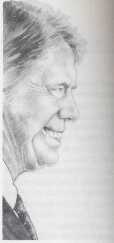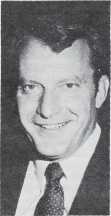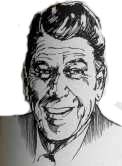 |
Home | Search | Browse | About IPO | Staff | Links |
 |
Home | Search | Browse | About IPO | Staff | Links |
|
By PETER W. COLBY and PAUL M. GREEN Election 1980: Downstaters decide Reagan outdrew Carter downstate, the area that cast the deciding ballots in the 1980 presidential election. Dixon was one of the few IN THE broadest terms, the 1980 presidential election in Illinois was simply a landslide for Ronald Reagan, who garnered a whopping 376,681 more votes than Jimmy Carter throughout the state. Even the much debated impact of John Anderson's campaign became a moot point in the face of that landslide, since Reagan would have won Illinois even if every one of Anderson's supporters had switched over to Carter (see table 1). In the course of the 1980 presidential contest, Illinois maintained its record as one of the most reliable indicators of national trends. Its highly competitive two-party system has made it one of only 13 states to vote the same way as the nation in 85 percent of this century's presidential contests. With 26 electoral votes at stake, all the candidates put major efforts into Illinois, and final pre-election polls were divided. The Associated Press and Time picked Carter, the Chicago Sun-Times Straw Poll pointed to Reagan, while Newsweek and U.S. News and World Report called Illinois too close to call. When the polls closed, however, Illinois was within 1 percent of mirroring the substantial nationwide margin for Reagan. 
But what went on in Illinois was
We have pointed out, in our article, "The consolidation of clout" (Illinois Issues, February 1979), that despite the decline in the size of the total vote in Chicago, the Democratic portion of the electorate has been steadily increasing, enough to offset the decline. Similarly, we have argued that although the power of the Democratic machine has been generally overrated, the changing socio-economic composition of the city's population more than counterbalanced the loss of party organizational strength. It was no surprise, then, that Carter's Chicago margin in 1980 was similar to that of 1976. As for the suburbs in the counties around Chicago, we have argued in "Patterns of change in suburban voting" (Illinois Issues, October 1979) that reports of a Democratic breakthrough transforming the previously Republican stronghold into a two-party battleground have been greatly exaggerated. GOP victory percentages there have remained quite stable as the population and total vote has grown rapidly, resulting in increasing voting margins for most Republican candidates. Taken as a unit, vote totals downstate fluctuate considerably more than in either the city or the suburbs, and final results are generally quite close to state totals. Chicago's decline To look at total state figures in Illinois, in other words, would not be helpful as a measure of the state's real political mood and tendencies. Each of the "landslides" must be examined individually so that contributing factors and strategic implications can revealed more clearly. Carter's sweep in Chicago must be looked at in a historical
6 | September 1981 | Illinois Issues


context, for example, while Reagan's landslides in the "suburbs" (those 5 1/2 non-Chicago collar counties) and "downstate" (the 96 remaining counties) must be separated from each other. At its simplest, that analysis suggests the truth of one of our earlier assertions, in "Downstate holds the key to victory" (Illinois Issues, February 1978), that currently Chicago and the suburbs will cancel each other out, making downstate the crucial factor in the election. Carter came out of the Chicago-suburban duel with a scant 18,699 lead, which was obliterated by Reagan's massive plurality of nearly 400,000 downstate (see table 1). Chicago has continued to decline as a determinant force in Illinois elections (see tables 1 and 2), and in 1980 the state's largest city cast less than one-fourth of the Illinois presidential vote. Chicago's 1980 total vote was over a half million less than the total city turnout in the 1960 John Kennedy-Richard Nixon contest. Over the last 20 years, most of the city's voter loss was picked up by the surrounding suburbs - while the downstate turnout remained pretty much the same (see table 2). Moreover, of Reagan's total statewide vote less than 13 percent of it came from Chicago (see table 1). In fact, if every Reagan voter in Chicago had stayed home on election day, the former Californian would still have carried Illinois. Inside Chicago, Carter ran roughshod over Reagan and Anderson. The former president captured 47 of the city's 50 wards and chalked up a 482,221 plurality over Reagan. Reagan was only able to capture the all-white, upper-middle class far northwest-side wards — the 38th, 41st and 45th. Moreover, there were only 10 other wards where Reagan won at least 40 percent of the vote, and there were 15 wards where Reagan was unable to win even a paltry 5 percent of the vote. Still-Democratic Chicago The Democratic landslide in Chicago was not unexpected. In 1976 Carter beat Gerald Ford in the city by 425,000 votes with a 67.7 percent plurality. In 1960 John Kennedy had defeated Richard Nixon in Chicago with a 63 percent plurality and a 456,000-vote margin. What is remarkable about recent Chicago presidential voting trends is that despite a decreasing city population and a subsequent lower total voter turnout, Democratic presidential candidates have increased their pluralities in the city. For example, in 1980 Carter's city vote was down a In 1980 a little over 300,000 Chicagoans voted for Reagan. The Anderson candidacy does complicate any direct comparison to 1976, but even if one adds all of Anderson's 58,413 voters to the Republican column (obviously not all Anderson voters were Republican — in fact, our guess is that a comfortable majority of them were Democrats and independents), the 1980 GOP Chicago vote would be down almost 28,000 from 1976. The main factor causing this GOP decline in Chicago is the growing number of black voters in the city. Black voter loyalty to the Democratic party is unquestionable. Reagan's combined vote in the 15 predominantly black city wards did not equal Carter's lowest single black ward plurality. Percentage wise none of these 15 black wards gave Carter less than 93 percent of their vote in a one-on-one match-up with Reagan. The rhythm of demographic change in Chicago finds the city gaining or retaining more staunch black Democratic voters while at the same time it is losing a greater number of potential white Republican voters. A large chunk of the remaining nonblack Chicagoans, both white and Hispanic, also support Democratic presidential candidates, though not to the same degree as their black counterparts. Thus, in 1980 Reagan was able to better Ford's 1976 spread against Carter in only one city ward — September 1981 | Illinois Issues | 7 the heavily Jewish far northside 50th ward. Even Chicago's Democratic Mayor Jane Byrne, in her major ticket-splitting effort to reelect Republican State's Attorney Bernard Carey in his race against her archenemy Democrat Richard M. Daley, could not shrink or alter Carter's city totals. Reagan demolished Carter and Anderson in the vote-rich suburban 5 1/2-county area surrounding Chicago (see table 3). He whipped Carter in suburban Cook by the same percentage margin as Ford beat the Georgian four years earlier. In the five collar counties (DuPage, Kane, Lake, McHenry and Will), Reagan upped the GOP percentage to an impressive 69 percent. Once again, the Anderson "no difference" is apparent in these results. Anderson made his best statewide showing in the 5 1/2-county area: in suburban Cook he took votes away from both major candidates in equal portions (see table 4), and in the collar counties his candidacy may have slightly hurt Carter, not Reagan. Suburbs and townships A closer look at suburban Cook reveals that Carter carried only two of 30 townships — Evanston and Calumet. In 1976 Evanston had been the Democratic candidate's only township triumph. A two-man comparison of the 1976 and 1980 presidential elections in suburban Cook (leaving out Anderson) shows Carter's percentage of the vote going up in 14 townships while his vote percentage dropped in the other 16. His greatest percentage increases were in Evanston, Calumet and Oak Park, and his biggest decreases took place in River Forest, Orland and Lemont. An analysis of Carter's 1980 and Kennedy's 1960 suburban Cook vote reveals some remarkable comparisons. Most startling is the similarity between each man's vote percentage in individual townships. The townships with the greatest similarity tend to be in the north and northwestern parts of Cook County, and they have remained stalwart Republicah in their political preference. On the other hand, a few townships like Evanston and Oak Park have become decidedly more Democratic in their presidential preference; the reason possibly being the influx of new black residents. Interestingly, some townships which have gained a large number of white Catholic former Chicagoans have become more erratic in their voting behavior. One such township is Worth, located southwest of the city, where Carter lost in 1980 by the same percentage and plurality as he did in 1976. However, Democratic state's attorney candidate Daley made remarkable vote gains in Worth compared to the 1976 Democratic state's attorney candidate. While Worth's ethnic voters spurned Carter's candidacy, enough latched onto Daley's bid to chop over 13,000 votes off the traditionally large Republican majority. And perhaps the most interesting of all facts concerning Daley's results in Worth township was that 56 more people cast ballots for state's attorney than voted for president! Thus, it can be argued that certain Democratic candidates, Carter not being one, can cut into normal Republican pluralities in heavily ethnic Cook County townships. GOP presidential vote power has become awesome in the collar counties during the last 20 years. Reagan beat Ford's spread against Carter in each of the five collar counties, with the Republican's biggest jump coming in Will County. DuPage, the most populous and most Republican of all the collar counties, has become to Illinois as Orange
In every corner and section of the state outside Chicago, Reagan smashed his opponents. Besides Cook County, Carter was able to win only two other Illinois counties — St. Clair and Alexander — both of which are in the deep southern part of the state. Traditionally, southern Illinois has been very hospitable to Democratic presidential candidates. The loyalty of the region's farmers, miners and union workers to the Democratic party stretches far back into the 19th century, but in 1980 they too bought into the Reagan landslide. According to the Southern Illinoisan, "... southern Illinois voters over-whelmingly cast their lot with Republican Ronald Reagan . . . [giving] former California Governor more than 55% of [their] votes." Downstate debacle In the western part of the state, the Rock Island Argus talked about an unexpected Reagan romp and its impact on local races. In central Illinois, the Champaign-Urbana News-Gazette called the election "an epic victory for the Republican party and an incredible rejection of the Democratic philosophy." And in the northern part of the state, the Rockford Register-Star wrote, "Illinois voters feeling the pinch of inflation and resentment toward big government, sent a testy give me no excuses message to their political leaders in this election." The political attitudes expressed in the press were reflected in the downstate vote returns. Except for Whiteside County, Reagan beat Ford's spread against Carter in every one of Illinois' 96 downstate counties. Reagan received 77,873 more total downstate votes than Ford won in 1976. Meanwhile, Carter's total downstate numbers dropped 204,623 votes from 1976 to 1980. The Democratic downstate debacle can be best described by looking at the vote margins given to Carter and Reagan. An examination of returns from the 96 downstate counties reveal some incredible vote turnarounds throughout the state. In St. Clair County in southwestern Illinois, Carter support dropped from a 18,844 plurality in 1976 to a 3,983 margin in 1980. In neighboring Madison County an even more amazing vote shift took place. In 1960 and 1976 Madison gave the Democratic presidential candidate approximately 12,000-vote pluralities in each election; in 1980 Reagan beat Carter in Madison County by 7,300 votes. The central part of the state saw perhaps the most dramatic presidential vote flip-flop. Heartland Illinois voters 8 | September 1981 | Illinois Issues
leaped aboard the Reagan bandwagon. There were astonishing GOP increases in the central Illinois counties of LaSalle, Peoria, Sangamon and Tazewell, which more than doubled Ford's 1976 margin and more than quadrupled Nixon's 1960 plurality. In the past we have argued that in Illinois "there are many different down-states" (see Illinois Issues, August 1978). Historically, not all of the 96 downstate counties have similar voting patterns, and in presidential elections downstaters have differed significantly in their political choices. However, in 1980 President Carter's reelection bid was rejected throughout almost all of downstate. In a post-election day editorial, the Quincy Herald-Whig summed up downstate feelings about the campaign and the defeated incumbent president: "For the White House, Americans most of all yearn for leadership and competence. They want a president to at least act like he understands the system and knows what he is doing. Jimmy Carter's instincts may have been good . . . but he could not communicate, even as he attempted to manipulate images, that he was a leader." Despite these regional differences, however, the composite state totals in Illinois were interesting since the state is considered a microcosm of the nation. Its combination of urban, suburban and rural regions makes it representative, as does its division into the "traditionalistic, moralistic and individualistic" political streams which Daniel Elazar says characterize the nation and which are all contained only in Illinois and Ohio. Those characteristics and the results of the election obviously suggest some halcyon days ahead for Republicans in Illinois and across the nation. If there was a ray of sunshine for Illinois Democrats in the 1980 election, it emanated from the smiling face of Alan J. Dixon. Dixon easily trounced his Republican opponent and Belleville neighbor then-Lt. Gov. Dave O'Neal to capture the U.S. Senate seat vacated by Adlai E. Stevenson III. Dixon's slogan, "A senator from Illinois for Illinois," capsulized his strategy of stressing state rather than national issues. And when O'Neal was forced to spend most of his time late in the campaign giving fumbling explanations about his use of state airplanes for political trips, his chance to ride home on the Reagan coattails slipped past.
Dixon's Democratic victory But Dixon's victory was much more a personal than a party triumph, and Democrats cannot take too much heart from such a win. Dixon in Illinois politics is simply an "election machine." He has never lost a political contest in 30 years; he has been state legislator, state treasurer and secretary of state. In his 1978 secretary of state reelection bid, Dixon "pitched a perfect game"; he won every county in the state, every township in Cook County, and every ward in Chicago; thus, any comparison between the GOP presidential triumph and the Democratic U.S. Senate victory must be tempered by the astounding statewide popularity of Dixon. Dixon beat O'Neal in all three statewide regions (see table 1). He squeaked by in the suburban 5 1/2 collar counties, narrowly won downstate and annihilated O'Neal in Chicago. The growing trend of voters splitting their tickets is quite obvious in Dixon's suburban and downstate returns. Many thousands of Illinois voters in these two regions cast a Reagan-Dixon ballot. In 1980, Dixon won a majority of downstate counties, a majority of Cook County townships and carried one of the five collar counties (Will). If future Democratic candidates in Illinois wish to win statewide, Dixon's election gives them a blueprint. Holding the GOP as even as possible downstate is the key; although Dixon received over 100,000 more votes in Chicago than did Carter, O'Neal and not Dixon would be the new Illinois junior U.S. Senator if Democrat Dixon had run as poorly as Democrat Carter did in the rest of the state. Democratic prospects in future presidential elections in Illinois, and, for that matter, upcoming 1982 statewide contests, do not look very promising. The Democratic party needs to break out of its urban stranglehold with new ideas, new programs and new people. No matter who wins the current battle for political control in Chicago, the Democratic party in one form or another will dominate in the city. But as the city turns out less and less of the statewide vote, candidates locked into this single constituency may find it impossible to win statewide races. To be sure, popular Democrats like Dixon or a Stevenson can still win in Illinois, but these Democrats are the exception rather than the rule. The 1980 presidential election in Illinois should lift the hearts of those in the Republican party. Political momentum is definitely on its side, and as long as the Democrats are unwilling or unable to break out of their Chicago roots, Republicans will have a relatively free ride in state contests. Reagan, after all, won Illinois without Chicago. His bedrock support in the 5 1/2 suburban counties canceled out Carter's Chicago margin, and it was once again downstate which proved to be the key to victory. PETER W. COLBY and PAUL M. GREEN have co-authored several articles on elections for Illinois Issues. Colby is director of the master's degree specialization program in public policy analysis and administration at State University of New York, Binghamton. Green is director of The Institute at Governors State University, Park Forest South. This article is a condensed version of the chapter, "The Election in Illinois, "from the forthcoming book, The Presidential Election in Transition, edited by Paul T. David and David H. Everson of Sangamon State University, Springfield. September 1981 | Illinois Issues | 9 |
|||||||||||||||||||||||||||||||||||||||||||||||||||||||||||||||||||||||||||||||||||||||||||||||||||||||||||||||||||||||||||||||||||||||||||||||||||||||||||||||||||||||||||
|
|